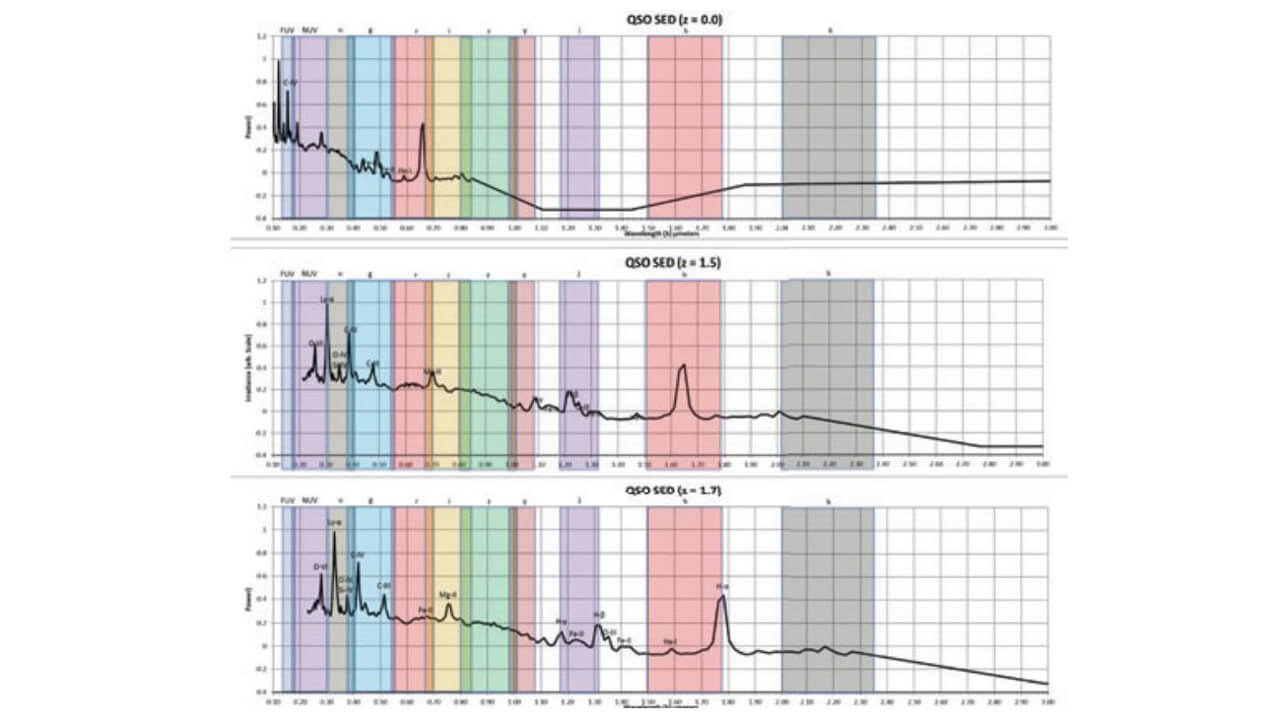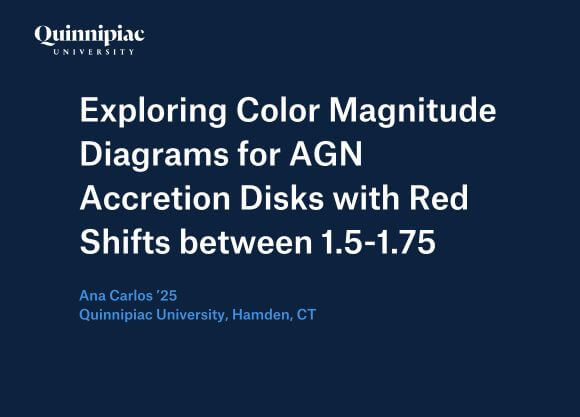
Figure 3. AGN SED ranging from z=0-1.75. At z=1.5-1.75 the UV emission shifts into the optical range with minimal contamination6.
QUIP-RS

QUIP-RS
This study aimed to examine the relationship between absolute magnitude and color index of active galactic nuclei (AGN).
This study looks at quasars from the COSMOS database with redshift values between 1.5 and 1.75, examining how their brightness (absolute magnitude) is related to their color.

Health Science Studies
School of Health Sciences
Fellow researchers: Nicole Granucci of Quinnipiac University; Varoujan Gorjian of NASA Jet Propulsion Laboratory; Thomas Rutherford of East Tennessee State University and King University; Grace Gogliettino of Colgate University; and Christian Jones of King University
Active Galactic Nuclei (AGN), particularly quasars, are characterized by their extremely high luminosities, making them important tools for measuring cosmic distances. The accretion disks of quasars can be modeled as black bodies, allowing them to be employed as "standard candles". Standard candles are objects with known luminosities that enable the calculation of distances through redshift. This research examines quasars extracted from the COSMOS database within the redshift range of 1.5 to 1.75, focusing on the relationship between absolute magnitude and color index. Color-magnitude diagrams and color-color plots were generated to explore these relationships.
Active Galactic Nuclei (AGN) are a classification of galaxies that are characterized by their highly concentrated galactic centers that are driven by a central supermassive black hole (SMBH) with a surrounding accretion disk2.
Unlike typical galaxies, AGN black holes actively accrete gas, dust, and other materials. This influx of matter forms a swirling accretion disk that surrounds the black hole. As matter enters the black hole, it is subjected to intense gravitational forces which convert it into thermal radiation. This causes extremely high luminosities even at large redshifts of 1.5-1.753. Current methods for determining galactic distances primarily rely on standard candles, such as Type 1A supernova. Although these methods have been effective in measuring objects at shorter distances, it becomes more inaccurate and difficult to measure deeper and fainter objects in the universe. Although Hubble’s Law can be applied to AGN, the linearity of this law diminishes at larger scales, which can lead to errors in distance measurements. Compared to Type 1a Supernova, AGN are newer objects in the universe since the Big Bang. As some of the most distant objects in the universe, their extreme luminosities measured at high redshifts offer a unique opportunity to determine cosmic parameters4.
Redshifts between 1.5 and 1.75 were selected based on the Spectral Energy Distribution (SED) of AGN, where UV emission shifts into the optical spectrum with minimal contamination, as seen in the COSMOS database (Figure 3). The contamination, visible as peaks in the SED in Figure 3, are indicative of electron transitions between energy levels rather than the thermal radiation from AGN accretion disks, which is the primary focus of this study. 56,590 AGN sources, spanning IR and optical data, were extracted, and the relevant columns for data reduction are shown in Table 1. Using the Ned Wright Cosmology Calculator, galactic distances were modeled, and initial color magnitude diagrams (CMDs) were generated. No significant correlations were found (Figure 4). To ensure only galaxies remained in the dataset, 446 nongalaxy sources identified by the column “lp_type” were removed, leaving 56,144 data points. After this adjustment, new CMDs were generated, again showing a poor R² correlation (Figure 5). A template from the Lephare library was used to classify AGN based on ID numbers, and after refining further with the "lp_modq" column, 22,177 type 1 AGN were identified. The resulting CMDs still showed poor R² correlations (Figure 6).
Due to inconclusive results across the entire redshift range, binning was introduced to observe correlations over smaller intervals. Binning was done in increments of +0.01 and +0.05. While results showed slight improvements, R² values remained unsatisfactory (Figure 7). This led to a shift in approach, focusing on confirming that the data contained only type 1 AGNs by exploring color-color plots. These plot color indices of specific bands on both axes. The subgroups “Blue Narrow”, “Red Narrow”, “IR Narrow”, “Wide Optical”, “Full Optical”, and “Wide IR were examined, and further binning by redshift (1.5-1.59, 1.6-1.69, 1.7-1.75). Results from revealed stronger R² correlations (Figure 8).
| Column Name | ID Number |
| ID | $1 |
| ALPHA_J2000 | $2 |
| DELTA_J2000 | $3 |
| UVISTA_K_MAG_APPER2 | $183 |
| Lp_zq | $604 |
| Lp_modq | $606 |
| IRAC_CH1_MAG | $549 |
| IRAC_CH2_MAG | $553 |
| HSC_g_MAG_APER2 | $55 |
| HSC_r_MAG_APER2 | $71 |
| HSC_i_MAG_APER2 | $87 |
| HSC_z_MAG_APER2 | $103 |
Table 1. Initial columns selected from COSMOS database for data reduction, representing both infrared (IR) and optical bands
"Working on this project has given me the opportunity to grow and prepare myself for a career as an aspiring dentist. My mentor, Professor Nicole Granucci, welcomed me onto her team in the Spring 2024 semester, and the amount of knowledge I've gained since then has been incredible. Working closely with her has really broadened my understanding and deepened my passion for the subject. This summer, I had the chance to be part of the QUIP-RS program, where I was immersed in a collaborative and supportive environment. Working alongside other students who were also conducting research allowed me to share ideas, ask questions, and learn about the diverse projects others were working on. This not only broadened my understanding about other topics but also helped me refine and improve my own work. The opportunity to collaborate with such a motivated group of people was an invaluable experience that pushed me to grow both personally and academically." - Ana Carlos '25
This serves as an overview of the project and does not include the complete work. To further discuss this project, please email Ana Carlos.
Quinnipiac University Interdisciplinary Program for Research and Scholarship
Open to students of all majors, QUIP-RS provides up to $5,000 in funding for undergraduate students to conduct research or complete creative projects alongside faculty mentors. This intensive 8-week program enables students to develop scholarly skills while encouraging discussion about successes and shortcomings with fellows and mentors.
Explore Our Areas of Interest
We've sorted each of our undergraduate, graduate and doctoral programs into unique Areas of Interest. Explore these categories to discover which programs and delivery methods best align with your educational and career goals.
References
1. Photo credit: Bahcall, Disney, NASA, 1996
2. Peterson, B. M. An introduction to active galactic nuclei, Publisher: Cambridge, New York Cambridge University Press, 1997.
3. Freedman R, Geller R, Kaufman III W. Universe. 9th Edition. W. H. Freedman. 2010.
4. Bisogni, E. Lusso, F. Civano, E. Nardini, G. Risaliti, M. Elvis, and G. Fabbiano, Qusars as standard Candles. “The Chandra view of the relation between X-ray and UV emission in quasars,” Astronomy & Astrophysics, in press, 2021. https://www.cfa.harvard.edu/news/quasars-cosmicstandard-candles
5. “Active Galactic Nucleus (Astronomy).” Encyclopedia Britannica, www.britannica.com/science/active-galacticnucleus/images-videos.
6. "The Next Generation Atlas of Quasar Spectral Energy Distributions from Radio to X-Rays" Zhaohui Shang et al The Astrophysical Journal Supplement, Volume 196, Issue 1, article id. 2, 23 pp. (2011)
7. Photo credit: NASA. (n.d.). Hubble Space Telescope - NASA Science. NASA. https://science.nasa.gov/mission/hubble/